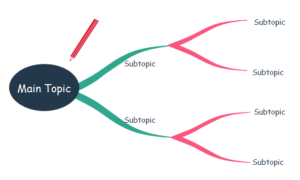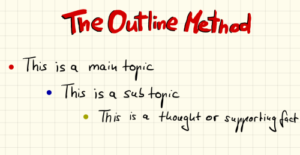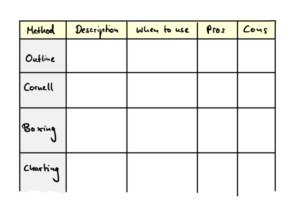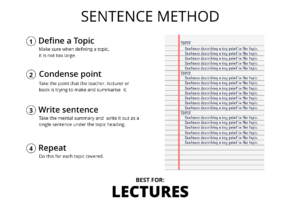
1. The Cornell Notetaking Method

This style of note taking is best for organizing the massive amount of information from a textbook into easily readable summaries. It’s known as one of the most effective methods because the main points, details, study cues, and summary are all written in the same place so it’s easy to refer back to.
- Divide the paper into 3 sections: a 2.5″ margin to the left, a 2″ summary section on the bottom, and a main 6″ notes section
- The main section is to write down bullet points or information that is important for later use
- The section to the left is for vocabulary words, study questions, and reviewing the notes from the main section
- The summary section at the bottom is for writing a couple of sentences about the notes. Here, it’s important to highlight the main points, so you prove your understanding of the concept.
2. The Mind Map Notetaking Method

This method is most useful for visual learners who struggle with studying from large blocks of text such as the ones in most textbooks. Mind maps help you remember and connect relationships between similar topics.
- Start by beginning the map with the main topic in the center of the notes sheet
- Then, branch off the main topic and write a heading for each of the subtopics
- Write any important notes under each subtopic and continue the pattern until it’s finished
- Later when reviewing, go more in depth and add smaller sub concepts onto each branch such as formulas, dates, supporting facts, and related concepts.
3. The Outlining Notetaking Method

This next way to take notes organizes topics using headings and bullet points. It’s best when learning about highly detailed topics because it allows the notes to be neatly organized. It’s also easy to see the relationship between the main topics and the subtopics, and it’s simple to turn the bullet points into study questions.
- Every section starts off with the heading of the main topics
- After that, write each supporting fact or subtopic underneath that heading
- When taking notes straight from the textbook, begin with one bullet point about the main topic
- Write the first subtopic below and make sure it’s indented slightly to the right
- Then, list other relevant information such as connections to other topics, specific details, and key points.
4. The Charting Notetaking Method

Taking notes using the charting method involves using columns to organize information. This is particularly helpful for a curriculum that covers many facts and relationships between topics. In this method, the facts remain organized and easy to review because the methods emphasizes the key information for each topic.
- Divide a page into columns labeled by category
- When you find information about a specific category, write it underneath the proper column
- When the next topic begins, move down one row and begin again
- This is primarily best for reviewing lots of facts quickly and in an easy manner; also, it helps when looking at a textbook because the categories will be easy to identify and the information will group itself naturally.
5. The Sentence Notetaking Method

This style of taking notes seems simple because you just need to write down each topic covered as a sentence. It works well for last minute studying or creating short study guides for future use. While you may miss some information in these notes, you will still have a general understanding of the text.
- Start by writing down important information in sentence form and start a new sentence for each new detail; each line on the page will be a new and separate topic
- Some may consider headings optional, but they can organize points by their main topic. Jotting down the main points will help you determine which information is most relevant and which isn’t
- This technique also helps when reviewing the notes because you’ll already have weeded out the irrelevant information.
Written by Anumita Basani
Visit the NSTEM page for more posts about our STEM community!

